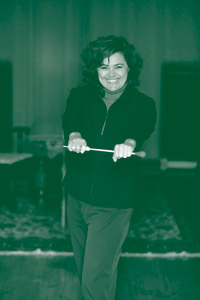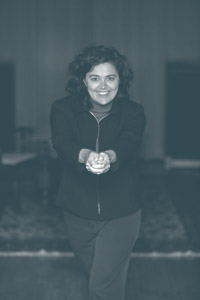Véronique Lacroix: On the Contemporary Beat! by Réjean Beaucage
/ May 5, 2003
Version française...
La Scena Musicale recently talked with Véronique Lacroix, founding
conductor and artistic director of the Ensemble contemporain de Montréal (ECM).
Acclaimed for her daring and visionary approach, Lacroix has been described in
Vancouver's Georgia Strait as "a conductor of outstanding prowess
and extraordinary puissance. . . . Like Leonard Bernstein, she has the uncanny
ability to call forth visual images from every note."
 Véronique Lacroix, who hails
from Chicoutimi in Quebec's Saguenay region, began studying music as a young
child. "My mother was a musician who played piano and cello," she explains. "As
in many Quebec families, my grandfather played an instrument and my grandmother
sang, but nobody was a professional musician. My mother decided to start musical
studies for her three children when we were very young. I began the violin at
four, moving on to the flute when I was about nine. The Conservatoire de musique
de Chicoutimi had opened recently, and it decided to admit very young pupils as
an experiment. I entered at the age of five! I owe a lot to Rosaire Simard, who
taught me solfege from the time I was admitted. He followed my development
closely and understood my particular aptitudes. He was also the choir director,
and one day when we were rehearsing (I must have been sixteen), he told me that
he could see me as an orchestra conductor!" Véronique Lacroix, who hails
from Chicoutimi in Quebec's Saguenay region, began studying music as a young
child. "My mother was a musician who played piano and cello," she explains. "As
in many Quebec families, my grandfather played an instrument and my grandmother
sang, but nobody was a professional musician. My mother decided to start musical
studies for her three children when we were very young. I began the violin at
four, moving on to the flute when I was about nine. The Conservatoire de musique
de Chicoutimi had opened recently, and it decided to admit very young pupils as
an experiment. I entered at the age of five! I owe a lot to Rosaire Simard, who
taught me solfege from the time I was admitted. He followed my development
closely and understood my particular aptitudes. He was also the choir director,
and one day when we were rehearsing (I must have been sixteen), he told me that
he could see me as an orchestra conductor!"
Although this wasn't all that long ago, there were hardly any models to
inspire a young girl toward choosing conducting as a career. Only a true
visionary could harbour such a daring ambition. Lacroix agreed to become
Simard's assistant choir conductor. A little later, Simard himself being
co-opted as a singer, Lacroix conducted Mozart's Requiem--her first major conducting experience. Shortly
after this, when she had just turned eighteen, the retiring conductor of the
Orchestre symphonique des jeunes de Chicoutimi offered her the podium. When her
flute studies at the Chicoutimi conservatory were completed, Lacroix decided to
continue her studies in Montreal (composition techniques such as harmony,
counterpoint, and fugue) before registering in the conducting program at the
Conservatoire de musique de Montréal.
"I probably thought the wait
would be fairly long when I did my entrance audition," she said. "But by the
second year, in 1986, I was told that Raffi Armenian had chosen me and that I
was the only candidate accepted. Some time later Clermont Pépin, then my
counterpoint teacher, suggested that I found my own ensemble, arguing that all I
needed was to get several colleagues together. That is how the Ensemble
contemporain du Conservatoire came into being in 1987--the predecessor of the
Ensemble contemporain de Montréal."
Lacroix, who has boundless
energy, wasn't satisfied with just one ensemble. Between 1987 and 1996 she led
the West Island Young People's Symphony, the Opéra Comique du Québec, the CAMMAC
orchestra, the Orchestre symphonique Joliette de Lanaudière, and the Scarborough
Philharmonic in Ontario.
Crossing musical borders
The ECM's first concert included
a Mozart serenade for two oboes, two clarinets, two French horns, and two
bassoons, and a work by Anthony Rozankovic (at the time a composition student),
using the same instruments. This combination of classical and contemporary
composers was a foretaste of the ECM's thematic concerts. We asked Véronique
Lacroix if this taste for contemporary music wasn't rather sudden. 
"Actually, it dates from way back," Lacroix answered. "I first encountered
contemporary music when studying the flute. Jean Morin, who taught me for nearly
ten years, had many twentieth-century scores. I think I must have been thirteen
when he asked me to play Arthur Honneger's Danse de la chèvre (1921) for
flute. I thought it had a distinctive sound, but it was just as normal for me to
learn a modern work as any other. It was mainly thanks to Morin, I think, that I
developed an open mind on the subject of today's music. I remember being very
impressed, when I was about sixteen, by Odile Vivier's book on Varèse (Éditions
du Seuil, 1973). For me, it was a given that a twentieth-century composer
represented modernity, and it was just as natural to be interested in today's
music--as a performer, conductor, or even a member of the public."
As artistic director of the ECM, Lacroix has made it a point of honour to
plan programs in which Mozart meets Rozankovic, Stravinski's instrumentation for
The Soldier'sTale serves for Estelle Lemire or the ensemble of Varèse's
Octandre for Jean Lesage. ECM's first concert of this type, in 1991, was
called "Siegfried . . . Un matin sur terre." Obviously the Siegfried
Idyll (1870) figured on the program, but so did Berg's Lyric Suite (1926) and works by Marc
Hyland and Liette Yergeau. The concert's theme was "total art," and featured
dance and visual works on stage. Since then, this multidisciplinary approach has
often been the focus of ECM events.
"I avoid doing the same thing
twice," explains Lacroix. "After putting something together, I prefer to break
the mould so that I have to do something new!"
Pushing the envelope
In 2002 the "Cage en liberté"
concert featured the works of John Cage (along with the creation of young local
composers, as usual), but this year the "great ancestor" has moved forward in
time and is none other than Steve Reich. Surprisingly, for the upcoming "Unions
Libres II" concert, Lacroix decided to invite the same composers who were
involved in the 2000 "Unions Libres."
"That's the surprise! Of course, everyone thought we would be inviting other
composers, but it will give these composers a chance to push the envelope when
thinking about the multidisciplinary approach, which is a real challenge,"
explains Lacroix. Once again, guest composers will be twinned with other artists
with whom they've conceived works we can see and hear. On the program are
L'union à la une by Sean Ferguson and writer Nathalie Mamias, Dialogue
sur d'infimes souvenirs by Michael Oesterle and painter Christine Unger,
Musique et film II by Yannick Plamondon and film maker Justin Antippa,
and Projets d'opéra by André Ristic and video creator Frédéric
Saint-Hilaire. Also on the bill as a prelude to an already generous program are
Steve Reich's Six Pianos and Louis Dufort's Piano Remix, the latter directly inspired
by Reich's piece. Video artist Yan Breuleux adds his touch to these two
works.
The ECM has garnered many honours recently, including the Opus 2002 prize for
the musical event of the year awarded by the Conseil québécois de la musique for
"Cage en liberté," and the Grand Prix du Conseil des arts de Montréal in March
2003 for the same concert. ECM players and their artistic director are primed
and more committed than ever to making contemporary music accessible to a larger
public. [Translated by Jane Brierley]
ECM's "Unions Libres II," a benefit concert,
takes place Tuesday, May 6, at 6:30 p.m. in the Salle Pierre-Mercure,
Centre
Pierre-Péladeau, Montreal. Info: (514) 524-0173 or www.ecm.qc.ca.
Version française... |
|


